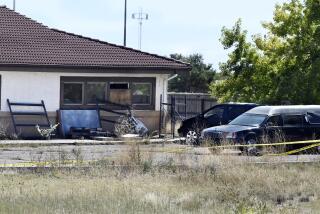Mix-up messes with eternity
- Share via
First, some history. In the late summer of 1951, 22-year-old Paul Siemasko was working the bar at the NCO club at Marine Corps headquarters outside Washington, D.C., when a young woman walked in. Her name was Charlotte Rose, from South Bend, Ind.
Things clicked. Paul, the New England Catholic, and Charlotte, the Midwestern Protestant, began dating. Six weeks later, when Charlotte was scheduled to return to her Marine base assignment in North Carolina, she promised to write. Nah, Paul said, that’s not the way things happen. People drift apart.
So he proposed.
Fifty-four years of married life later, in January 2006, Charlotte Siemasko died of lung cancer. It came upon her quickly, but in the years before, she and Paul, by then longtime Orange Countians, had decided to be buried in Riverside National Cemetery.
In February 2006, Charlotte’s cremated remains were buried in Plot 361. No. 362 would be Paul’s.
Or so he thought.
We’re on the phone, and Siemasko isn’t angry as he tells his story. People make mistakes, he says. He thinks he’s been wronged but isn’t banging the table over it. He just wants to know what to do about the fact that the small plot of ground next to Charlotte’s remains is now occupied by those of an Air Force senior airman.
Which creates a conundrum. If Siemasko, 79, wants to spend eternity next to his wife, the government must either disinter her remains and relocate them or do the same to the airman.
The cemetery is perfectly willing to do the former but not the latter.
Although sympathetic to Siemasko, cemetery officials say he’s at fault for not giving them proof of his military service when his wife’s ashes were buried. So, they say, the space he thought was his remained available. There’s no way, they say, they’re digging up the remains of the blameless airman whose family claimed the spot.
Siemasko gets it -- sort of. But two months after one of his daughters first discovered the mix-up during a visit to the cemetery, he’s still tied up in knots.
“I think I’m a compassionate and non-vindictive person,” he says. “I’m not trying to cause a lot of waves. I was pretty upset when they said it’s not the other family’s fault. Of course, I know that, but it’s not our family’s fault either.”
Cemetery officials have offered to move Charlotte’s remains and set aside an adjoining space for Paul. They also offered companion above-ground niches.
“I need more time to make a decision on this,” Siemasko says.
He’s upset that cemetery officials seemed to ignore his original complaints. When they did contact him, he says, he got various answers as to what had gone wrong. When I told him last week that a cemetery official told me the real problem was that Siemasko hadn’t given verification of his military status, that irritated him. They’d never told him that, he says.
I can’t arbitrate a bureaucratic dispute. A cemetery official says Siemasko needed to submit proof of military service within 24 hours of his wife’s burial.
Really?
Yes, says Nathan Maino, the cemetery official who’s been working with Siemasko. “Anybody can claim they’re a vet,” he says. “Unless they give us a piece of paper. . . . He should have done that a couple days before we buried his wife, had that card filled out.”
Even if someone told Siemasko that, is it reasonable to expect a spouse to make a mental note of everything said to him or her while making funeral plans?
To me, it isn’t.
Maino isn’t the least argumentative or defensive when discussing Siemasko. “I feel bad for him,” he says. “I’m kind of 50-50 on this one. I got 23 years active duty. He’s retired military. We feel for these vets coming here.”
Siemasko was a career Marine, and Maino has never doubted that. He says this is only the second time in the last five years that a mix-up like this has occurred.
The new plots offered to Siemasko are in excellent locations, Maino says. “When you pull over to pay a visit, you get out of the car, walk a couple feet and you’re next to the new grave,” he says. “My supervisor said give him anything he wants and don’t require any paperwork.”
Siemasko, who has remarried, hasn’t given the go-ahead to disinter Charlotte. He can’t shake the thought that he’s making the sacrifice for something that wasn’t his fault. He wants to take some time to research whether the mix-up is common. If it is, he says, he might take a more hard-line position as a means of holding the cemetery accountable.
“To err is human, to forgive divine and all that,” Siemasko says. “If I’m sure it’s an isolated mistake, that’s one thing. But if it’s one of many problems. . . .”
If Siemasko decides on the new plots, I ask Maino, how quickly will Charlotte Siemasko’s remains be disinterred?
Not long, he says. “We’re gonna move her when he tells us to.”
--
More to Read
Sign up for Essential California
The most important California stories and recommendations in your inbox every morning.
You may occasionally receive promotional content from the Los Angeles Times.













